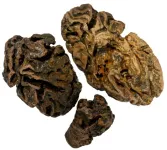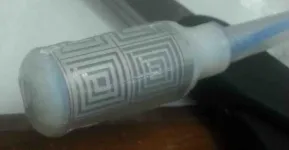(Press-News.org) A major report on the remains of a stilt village that was engulfed in flames almost 3,000 years ago reveals in unprecedented detail the daily lives of England’s prehistoric fenlanders.
Must Farm, a late Bronze Age settlement, dates to around 850BC, with University of Cambridge archaeologists unearthing four large wooden roundhouses and a square entranceway structure – all of which had been constructed on stilts above a slow-moving river.
The entire hamlet stood approximately two metres above the riverbed, with walkways bridging some of the main houses, and was surrounded by a two-metre-high fence of sharpened posts.
The settlement was less than a year old when it was destroyed by a catastrophic fire, with buildings and their contents collapsing into the muddy river below. The combination of charring and waterlogging led to exceptional preservation. The site has been described as “Britain’s Pompeii”.
Years of research conducted on thousands of artefacts from the site have now shown that early Fen folk had surprisingly comfortable lifestyles, with domestic layouts similar to modern homes, meals of “honey-glazed venison” and clothes of fine flax linen, and even a recycling bin.
The settlement-on-stilts also contained a stack of spears with shafts over three metres long, as well as a necklace with beads from as far away as Denmark and Iran, and a human skull rendered smooth by touch, perhaps a memento of a lost loved one.
The Cambridge archaeologists say the site provides a unique “blueprint” for the circular architecture, home interiors and overall domesticity of those who inhabited the swampy fenland of East Anglia some eight centuries before Romans set foot on British shores.
Full findings from the Must Farm site – excavated by the Cambridge Archaeological Unit (CAU) in 2015-16 after its discovery on the edge of Whittlesey near Peterborough – are published in two reports, both made available by Cambridge’s McDonald Institute for Archaeological Research.
“These people were confident and accomplished home-builders. They had a design that worked beautifully for an increasingly drowned landscape,” said CAU’s Mark Knight, report co-author and excavation director.
“While excavating the site there was a sense that its Bronze Age residents had only just left. You could almost see and smell their world, from the glint of metal tools hanging on wattled walls to the sharp milkiness of brewed porridge.”
‘Mirror’ of ancient home interiors
The ruins of five structures were uncovered, along with walkways and fencing, but the original settlement was likely twice as big – half the site was removed by 20th century quarrying – with researchers saying it may have held up to sixty occupants in family units.
The river running underneath the community would have been shallow, sluggish and thick with vegetation. This cushioned the scorched remains where they fell, creating an archaeological “mirror” of what had stood above – allowing researchers to map the layout of the structures.
One of the main roundhouses, with almost fifty square metres of floor space, appeared to have distinct activity zones comparable to rooms in a modern home.
“Conducting research on Must Farm is a bit like getting an estate agent’s tour of a Bronze Age stilt house,” said David Gibson, report co-author and Archaeological Manager at CAU.
Ceramic and wooden containers, including tiny cups, bowls, and large storage jars, were found in the northeast quadrant of “Structure One”, the location of a kitchen. Some pots were even nested: designed to stack inside one another to save space.
Metal tools were stored along the building’s eastern side, while the empty northwest area was probably reserved for sleeping. The southeast space had lots of cloth fragments, along with bobbins and loom weights. This was close to a likely entrance, where extra light would have helped with textile work.
The roundhouse’s southwest quadrant was reserved for keeping lambs indoors. There was no evidence of humans dying in the fire, but several young sheep had been trapped and burnt alive.
Skeletal remains showed the lambs were three to six months old, suggesting the settlement was destroyed sometime in late summer or early autumn. Evidence that the wooden architecture was still “green” confirms construction took place around nine months to a year earlier.
Tool kits, textiles and a token of good luck
Household inventories were remarkably consistent. All the roundhouses contained a metalwork “tool kit” that included sickles (crop-harvesting blades) along with axes and curved “gouges” used to hack and chisel wood, as well as hand-held razors for cutting hair.
Most buildings had objects for making textiles, from spindle whorls to thread bobbins, although the distribution suggests that “spinning” – the process of twisting fibres together – was conducted in three of the roundhouses, but Structure One was where this yarn got converted to fabrics.
The textiles are the finest of this period found in Europe, with details such as “pile tufts” that would have given garments a soft, almost velvety feel, and “tubular selvedge” for neat seams and hems.
Each roundhouse roof had three layers: insulating straw topped by turf and completed with clay – making them warm and waterproof but still well ventilated. “In a freezing winter, with winds cutting across the Fens, these roundhouses would have been pretty cosy,” said CAU project archaeologist Dr Chris Wakefield.
Structure Four, a smaller square building, may also have acted as the settlement’s entrance. A large wooden bucket had been kept within, containing several damaged bronze objects and worn axe-heads, waiting to be smelted down and recycled into new tools.
Encircling the footprint of each roundhouse were “middens”, haloes of rubbish dumped from the stilt village above, included broken pots, butchered animal bone, and “coprolites” or fossilised faeces. Some human coprolites had parasite eggs, suggesting inhabitants struggled with intestinal worms.
One item, however, had been placed in the silt directly beneath Structure One: an intact hafted axe, perhaps a token of good fortune, or an offering to some kind of spirit on completion of the build.
‘Meaty porridge’
Despite millennia in the mud, many artefacts still bore traces of daily life – along with its sudden interruption as inhabitants abandoned their possessions to escape the blaze.
For example, a pottery bowl with the finger-marks of its maker captured in the clay was found still holding its final meal: a wheat-grain porridge mixed with animal fats (possibly goat or red deer). The wooden spatula used for stirring was resting against the inside of the bowl.
“It appears the occupants saved their meat juices to use as toppings for porridge,” said Dr Chris Wakefield. “The site is providing us with hints of recipes for Bronze Age breakfasts and roast dinners.”
“Chemical analyses of the bowls and jars showed traces of honey along with ruminant meats such as deer, suggesting these ingredients were combined to create a form of prehistoric honey-glazed venison.”
The stilt-house dwellers even had favourite cuts of meat, often only bringing the forelegs of a boar back for roasting, for example. Preferred aquatic dishes included pike and bream.
Several small dog skulls suggest the animals were kept domestically, perhaps as pets but also to help flush out prey on a hunt. Dog coprolites show they fed on scraps from their owners’ meals.
Must Farm’s residents used the local woodlands – evidence suggests within a two-mile radius – to hunt boar and deer, graze sheep, and harvest crops such as wheat and flax as well as wood for construction. Waterways were vital for transporting all these materials.
The remains of nine log-boats, canoes hollowed from old tree trunks, were found upstream, dating from across the Bronze and into the Iron Age, included some that were contemporary to Must Farm.
“Boat journeys through reed swamps to the woodlands would have been made many times during the site’s short life,” said Wakefield. “In summer, that meant traversing clouds of mosquitos.”
Much of what was retrieved from Must Farm were everyday items, the Bronze Age equivalent to the TV remotes and coffee mugs of our own lives. However, some items would have been precious.
A necklace of beads made from glass, amber, siltstone and shale had been lost in the fire. In fact, decorative beads were found right across the site. All but one of Must Farm’s 49 glass beads came from far-flung places, including Northern and Eastern Europe, and even the Middle East.
“Such items would gradually make their way across thousands of miles in a long series of small trades,” said Wakefield.
Up in flames…
The researchers say that, while the Bronze Age could be violent, and aspects of the site’s structure are clearly defensive, its location may be as much to do with resources. Spears found on site, up to 3.4 metres in length, as well as swords, were as likely to be used in animal hunts as on rival groups.
A few human remains were recovered, including the skull of an adult woman polished by repeated touch – a sign this may have been a keepsake of love rather than war.
“The cause of the fire that tore through the settlement will probably never be known,” said CAU’s David Gibson. “Some argue it may have come under attack, as the occupants never returned for their goods, which would have been fairly easy to retrieve from the shallow waters”.
However, others think it more likely to have been an accident. If an internal fire took hold in one of the roundhouses, it would spread between the tightknit structures within minutes.
Added Gibson: “A settlement like this would have had a shelf-life of maybe a generation, and the people who built it had clearly constructed similar sites before. It may be that after the fire, they simply started again.”
“There is every possibility that the remains of many more of these stilted settlements are buried across Fenland, waiting for us to find them.”
The major £1.1 million excavation project was funded by Historic England and building supplier Forterra. It was carried out by Cambridge Archaeological Unit of the University of Cambridge. The remains were removed for recording and analysis due to concerns about the location and future preservation of the site.
END
Study reveals ‘cozy domesticity’ of prehistoric stilt-house dwellers in England’s ancient marshland
2024-03-20
ELSE PRESS RELEASES FROM THIS DATE:
New archive of ancient human brains challenges misconceptions of soft tissue preservation
2024-03-20
Soft tissue preservation in the geological record is relatively rare, and, except where deliberate intervention halts the process of decay (like embalming or freezing), the survival of entire organs is particularly unusual. The spontaneous preservation of the brain in the absence of any other soft tissues - that is, the brain’s survival amongst otherwise skeletonised remains - has historically been regarded as a ‘one-of-a kind’ phenomenon.
A new study conducted by researchers at the University of Oxford, led ...
Swallowable sensors could pinpoint gut movement problems for patients
2024-03-20
Scientists have developed an ingestible capsule dotted with sensors that can detect pressure in a patient’s guts and detect points of failure.
The ingestible system will give colorectal medical teams an unprecedented understanding of the movement of a patient’s digestive tract, or lack thereof.
Instead of simply taking images of inside the guts, the system will sense whether it’s contracting, how much pressure is exerted and exactly where it might be inactive.
The system has been tested in a synthetic gut and animals. A patent for the technology is pending.
The team from Heriot-Watt University and the University of Birmingham, with colleagues from the University ...
Genetic test identifies patients with triple negative breast cancer who are unlikely to respond to immunotherapies
2024-03-20
Milan, Italy: Researchers have developed a genetic test that can identify how patients with triple negative early-stage breast cancer will respond to immunotherapy drugs. This means that patients who are unlikely to respond to these drugs can avoid the adverse side effects associated with them and can be treated with other therapies.
Professor Laura van ‘t Veer told the 14th European Breast Cancer Conference that the latest results from the I-SPY2 trial [1] suggest that the current standard of care for patients with triple negative breast cancer should be reconsidered.
“Immunotherapy drugs can ...
Similar DNA changes found in cells of both smokers and e-cigarette users
2024-03-20
E-cigarette users with a limited smoking history experience similar DNA changes to specific cheek cells as smokers, finds a new study led by researchers at UCL (University College London) and University of Innsbruck.
This study is an incremental step in helping researchers to build a deeper understanding of the long-term effects of e-cigarettes on health. Although it does not show that e-cigarettes cause cancer, studies with long-term follow up are important to assess whether e-cigarettes have harmful effects and, if so, what they are.
The study, published in Cancer Research, ...
New data show pembrolizumab improves breast cancer outcomes regardless of age or menopausal status
2024-03-20
Milan, Italy: New data from the KEYNOTE-756 phase 3 clinical trial show that adding the immunotherapy drug, pembrolizumab, to chemotherapy before and after surgery for breast cancer leads to better outcomes for patients regardless of their age or menopausal status.
The findings, presented at the 14th European Breast Cancer Conference (EBCC 14) today (Wednesday), add to information available on the effect of pembrolizumab in patients with early-stage breast cancer that is at high risk of recurring or spreading further, and that is oestrogen ...
UTA federal research projects add $38 million to economy
2024-03-19
The economic impact of federally sponsored research at The University of Texas at Arlington was $38 million in 2022, with expenditures spread among 725 unique vendors, according to a new report. Of that total, the University spent about $24 million on research-related goods and services in Texas.
The research dollars also supported the salaries of 1,562 people during this time—including 517 faculty and 746 students.
“Research at UTA helps solve some of society’s most important problems, and it is also a vital economic driver in our economy and in the careers of our students and researchers,” said Kate Miller, vice president of research and ...
Rice researchers develop 3D-printed wood from its own natural components
2024-03-19
Researchers at Rice University have unlocked the potential to use 3D printing to make sustainable wood structures, offering a greener alternative to traditional manufacturing methods.
Wood has historically been marred by wasteful practices generated during shaping processes, driving up costs and environmental impact. Now researchers in materials science and nanoengineering at Rice have developed an additive-free, water-based ink made of lignin and cellulose, the fundamental building blocks of wood. The ink can be used to produce architecturally ...
Machine learning used to classify fossils of extinct pollen
2024-03-19
In the quest to decipher the evolutionary relationships of extinct organisms from fossils, researchers often face challenges in discerning key features from weathered fossils, or with prioritizing characteristics of organisms for the most accurate placement within a phylogenetic tree. Enter neural networks, sophisticated algorithms that underlie today’s image recognition technology.
While previous attempts to utilize neural networks in classifying extinct organisms within phylogenetic trees have struggled, a new study, recently published in PNAS Nexus, heralds a significant breakthrough. The model has been trained ...
Researchers identify key regulators underlying regeneration in Drosophila
2024-03-19
Some animals possess the remarkable ability to regenerate lost structures, exemplified by a lizard regrowing its tail. However, this regenerative process must be tightly regulated by the body to ensure proper tissue organization and to prevent abnormal growths, such as cancer. Yet, the precise mechanisms underlying this regulation are not well known. In a recent study published in PLOS Genetics, researchers at the University of Illinois Urbana-Champaign have identified an RNA-regulator called Brat as a key player in restraining tissue regeneration through its modulation of downstream growth factors.
“There are constraints and protective factors that are important for ...
HIV in cell culture can be completely eliminated using CRISPR-Cas gene editing technology, increasing hopes of cure
2024-03-19
**Note: the release below is a special early release from the European Congress of Clinical Microbiology and Infectious Diseases (ECCMID 2024, Barcelona, Spain, 27-30 April). Please credit the congress if you use this story**
New research presented early ahead of this year’s European Congress of Clinical Microbiology and Infectious Diseases (ECCMID 2024, Barcelona, 27-30 April) from a team of researchers in the Netherlands shows how the latest CRISPR-Cas gene editing technology can be used to eliminate all ...










